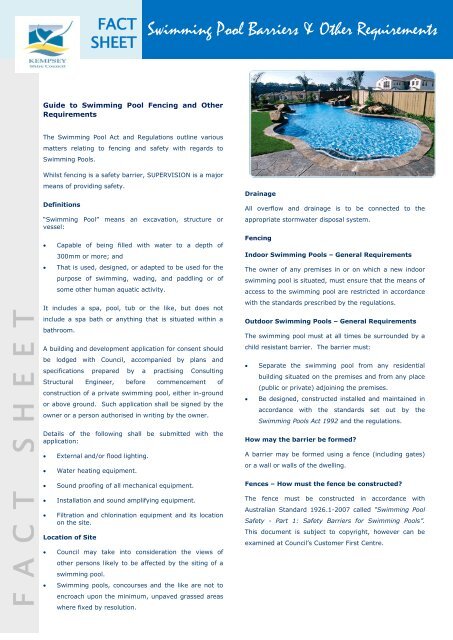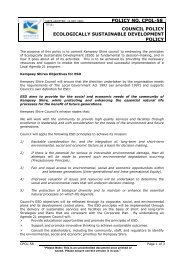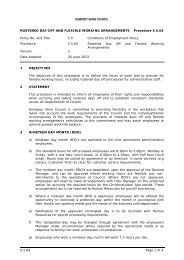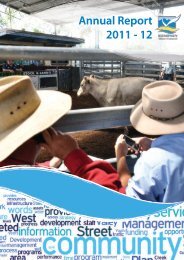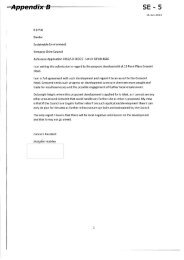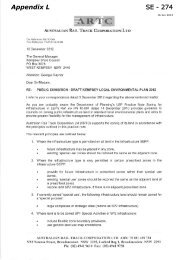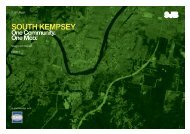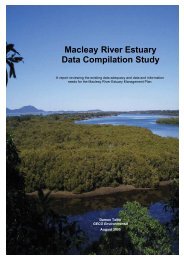Swimming pool barriers & other requirements - Fact sheet (PDF ...
Swimming pool barriers & other requirements - Fact sheet (PDF ...
Swimming pool barriers & other requirements - Fact sheet (PDF ...
Create successful ePaper yourself
Turn your PDF publications into a flip-book with our unique Google optimized e-Paper software.
F A C T S H E E T<br />
FACT<br />
SHEET<br />
<strong>Swimming</strong> Pool Barriers & Other Requirements<br />
Guide to <strong>Swimming</strong> Pool Fencing and Other<br />
Requirements<br />
The <strong>Swimming</strong> Pool Act and Regulations outline various<br />
matters relating to fencing and safety with regards to<br />
<strong>Swimming</strong> Pools.<br />
Whilst fencing is a safety barrier, SUPERVISION is a major<br />
means of providing safety.<br />
Definitions<br />
“<strong>Swimming</strong> Pool” means an excavation, structure or<br />
vessel:<br />
<br />
<br />
Capable of being filled with water to a depth of<br />
300mm or more; and<br />
That is used, designed, or adapted to be used for the<br />
purpose of swimming, wading, and paddling or of<br />
some <strong>other</strong> human aquatic activity.<br />
It includes a spa, <strong>pool</strong>, tub or the like, but does not<br />
include a spa bath or anything that is situated within a<br />
bathroom.<br />
A building and development application for consent should<br />
be lodged with Council, accompanied by plans and<br />
specifications prepared by a practising Consulting<br />
Structural Engineer, before commencement of<br />
construction of a private swimming <strong>pool</strong>, either in-ground<br />
or above ground. Such application shall be signed by the<br />
owner or a person authorised in writing by the owner.<br />
Drainage<br />
All overflow and drainage is to be connected to the<br />
appropriate stormwater disposal system.<br />
Fencing<br />
Indoor <strong>Swimming</strong> Pools – General Requirements<br />
The owner of any premises in or on which a new indoor<br />
swimming <strong>pool</strong> is situated, must ensure that the means of<br />
access to the swimming <strong>pool</strong> are restricted in accordance<br />
with the standards prescribed by the regulations.<br />
Outdoor <strong>Swimming</strong> Pools – General Requirements<br />
The swimming <strong>pool</strong> must at all times be surrounded by a<br />
child resistant barrier. The barrier must:<br />
Separate the swimming <strong>pool</strong> from any residential<br />
building situated on the premises and from any place<br />
(public or private) adjoining the premises.<br />
Be designed, constructed installed and maintained in<br />
accordance with the standards set out by the<br />
<strong>Swimming</strong> Pools Act 1992 and the regulations.<br />
Details of the following shall be submitted with the<br />
application:<br />
How may the barrier be formed?<br />
<br />
<br />
<br />
External and/or flood lighting.<br />
Water heating equipment.<br />
Sound proofing of all mechanical equipment.<br />
A barrier may be formed using a fence (including gates)<br />
or a wall or walls of the dwelling.<br />
Fences – How must the fence be constructed?<br />
<br />
<br />
Installation and sound amplifying equipment.<br />
Filtration and chlorination equipment and its location<br />
on the site.<br />
Location of Site<br />
<br />
<br />
Council may take into consideration the views of<br />
<strong>other</strong> persons likely to be affected by the siting of a<br />
swimming <strong>pool</strong>.<br />
<strong>Swimming</strong> <strong>pool</strong>s, concourses and the like are not to<br />
encroach upon the minimum, unpaved grassed areas<br />
where fixed by resolution.<br />
The fence must be constructed in accordance with<br />
Australian Standard 1926.1-2007 called “<strong>Swimming</strong> Pool<br />
Safety - Part 1: Safety Barriers for <strong>Swimming</strong> Pools”.<br />
This document is subject to copyright, however can be<br />
examined at Council’s Customer First Centre.
F A C T S H E E T<br />
FACT<br />
SHEET<br />
<strong>Swimming</strong> Pool Barriers & Other Requirements<br />
How high must the fence be?<br />
Fences and gates shall be at least 1.2 metres in height at<br />
any point along their length, on the outside of the fencing.<br />
If the property boundary fence is used as part of the<br />
swimming <strong>pool</strong> fence, then the fence shall be at least 1.8<br />
metres in height at any point along the length on the<br />
inside of the enclosure with a non-climbable zone of<br />
900mm from the top of the fence.<br />
reach over or through the fencing at a height greater<br />
than 1.2 metres above finished ground level.<br />
Should the fence go down to the ground?<br />
The height of any opening between the bottom of the<br />
fence and the ground shall not exceed 100mm.<br />
What is the maximum opening between vertical<br />
components?<br />
The spacing between any adjacent vertical members shall<br />
not exceed 100mm at any point.<br />
Where may horizontal components be constructed?<br />
Horizontal members which are located on the outside of<br />
the fencing or when on the inside, the gap between the<br />
uprights is more than 10mm, shall be at least 900mm<br />
apart and the top surface of the lowest horizontal member<br />
shall be at least 1.1 metres below the top of the fence or<br />
gate.<br />
Gates<br />
Which way must the gate swing?<br />
Be at least 150mm below the top of the fencing<br />
where a hand-hold is not provided, or at least<br />
150mm away from the edge of any hand-hold<br />
opening where a hand-hold is provided.<br />
It may be necessary to provide suitable screening of<br />
the latch for a radius of 450mm from the latch.<br />
Walls<br />
Walls are to be of substantial construction, have vertical<br />
sides and have a height of at least 1.2m.<br />
Windows in the wall must be of substantial construction<br />
and be fixed so that it has no opening through which a<br />
105mm diameter bar will pass through.<br />
The gate must open towards the person seeking entry<br />
into the <strong>pool</strong> area.<br />
What kind of latch is required?<br />
Gates shall be fitted with a self latching device that will<br />
automatically operate on the closing of the gate and will<br />
prevent the gate from being re-opened without manually<br />
releasing the mechanism.<br />
Where must the latch be located?<br />
Where the release of the latching device is located at a<br />
height less than 1.5 metres above finished ground level,<br />
or where the latch itself located at a height less than 1.5<br />
metres above finished ground level, the latch shall:<br />
Warning Signs<br />
You must display a warning notice which contains<br />
resuscitation information. The notice is to be displayed in<br />
a prominent position and meet specific <strong>requirements</strong>.<br />
Noise<br />
At any time the noise emanating from the swimming <strong>pool</strong><br />
pump is not to create offensive noise.<br />
DISCLAIMER<br />
This information is only a guide and should be<br />
read in conjunction with the <strong>Swimming</strong> Pools Act<br />
1992 and Australian Standard 1926.1-2007<br />
“<strong>Swimming</strong> Pool Safety - Part 1: Safety Barriers<br />
for <strong>Swimming</strong> Pools”.<br />
<br />
<br />
Not be on the outside of the fencing.<br />
Be in such a position that to release the latching<br />
mechanism from the outside, it will be necessary to<br />
For further information and advice on<br />
<strong>Swimming</strong> Pool Fencing and Other Requirements<br />
Contact:<br />
Kempsey Shire Council<br />
22 Tozer Street, West Kempsey<br />
Ph (02) 6566 3200 Fax (02) 6566 3205<br />
www.kempsey.nsw.gov.au


